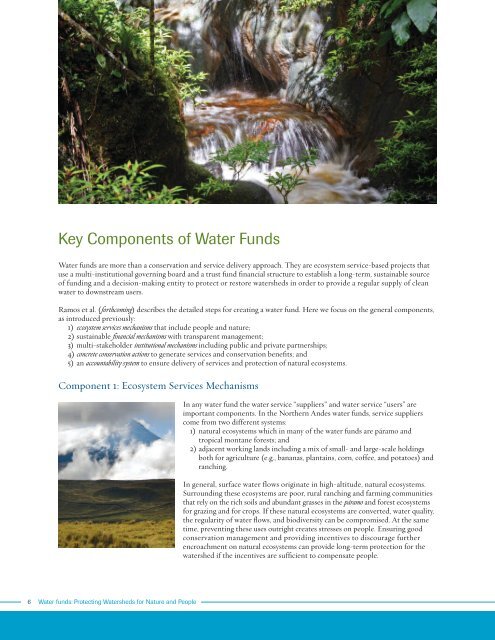Key Components of <strong>Water</strong> <strong>Funds</strong><strong>Water</strong> funds are more than a conservation and service delivery approach. They are ecosystem service-based projects thatuse a multi-institutional governing board and a trust fund financial structure to establish a long-term, sustainable sourceof funding and a decision-making entity to protect or restore watersheds in order to provide a regular supply of cleanwater to downstream users.Ramos et al. (forthcoming) describes the detailed steps for creating a water fund. Here we focus on the general components,as introduced previously:1) ecosystem services mechanisms that include people and nature;2) sustainable financial mechanisms with transparent management;3) multi-stakeholder institutional mechanisms including public and private partnerships;4) concrete conservation actions to generate services and conservation benefits; and5) an accountability system to ensure delivery of services and protection of natural ecosystems.Component 1: Ecosystem Services MechanismsIn any water fund the water service “suppliers” and water service “users” areimportant components. In the Northern Andes water funds, service supplierscome from two different systems:1) natural ecosystems which in many of the water funds are páramo andtropical montane forests; and2) adjacent working lands including a mix of small- and large-scale holdingsboth for agriculture (e.g., bananas, plantains, corn, coffee, and potatoes) andranching.In general, surface water flows originate in high-altitude, natural ecosystems.Surrounding these ecosystems are poor, rural ranching and farming communitiesthat rely on the rich soils and abundant grasses in the páramo and forest ecosystemsfor grazing and for crops. If these natural ecosystems are converted, water quality,the regularity of water flows, and biodiversity can be compromised. At the sametime, preventing these uses outright creates stresses on people. Ensuring goodconservation management and providing incentives to discourage furtherencroachment on natural ecosystems can provide long-term protection for thewatershed if the incentives are sufficient to compensate people.6 <strong>Water</strong> funds: Protecting <strong>Water</strong>sheds for Nature and People
The end users of the water services (those who will provide the incentives to the service providers) vary by water fund butgenerally include public water utilities, major public hydroelectric facilities, irrigation systems and agricultural associations,and private companies such as beer companies (e.g., Cervecería Nacional in Ecuador and Bavaria in Colombia) and bottledwater companies (e.g. ,Tesalia in Ecuador). End users have an incentive to invest in conservation efforts in areas that willyield the greatest return of services they value. A variety of feasibility studies can be used to prioritize water fund investmentsand identify areas of high service supply.Such studies use a variety of models and tools—hydrological, ecological, and socioeconomic—to map service flows and todemonstrate through scenarios the importance of watershed conservation to the supply of water services. In addition, thestudies should include an analysis of the water users often with financial details and potential revenue streams. Feasibilitystudies can be used to engage stakeholders, establish finances, set objectives, develop strategies, and prioritize areas forwater fund investment within the watershed.For example, In the Agua por la vida y la sostenibilidad water fund in the East Cauca Valley of Colombia, TNC is using avariety of models to help prioritize water fund investments. Currently, TNC and two partners—Centro Internacionalpara Agricultura Tropical (CIAT) and Kings College in London—are conducting research to analyze the effectiveness ofthree different water models to identify priorities for water fund investment in this watershed: the Soil and <strong>Water</strong> AssessmentTool (SWAT), Fog Interception for the Enhancement of Streamflow in Tropical Areas (FIESTA), and the IntegratedValuation of Ecosystem Services (InVEST).Feasibility studies can also be used to assess the impact of climate change on water fund investments and to reprioritize orchange strategies accordingly. InVEST, a tool developed by The <strong>Natural</strong> <strong>Capital</strong> <strong>Project</strong> (a partnership between TNC,Stanford University’s Woods Institute for the Environment, and World Wildlife Fund), maps, quantifies, and values theflow of ecosystem services from the landscape. The maps are especially relevant for land-use planning and for assessingimpacts on services under different land-use and, potentially, climate scenarios. It is now being used in East Cauca Valleywatershed to assess the impacts of climate change on the watershed. From there, TNC and partners will developadaptation strategies based on the model outputs.A final example of the use of feasibility studies is the Bogota water fund. TNC and other water fund stakeholders workedwith CIAT and Econometría to articulate the importance of watershed conservation and the technical, financial, and legaloptions for creating the fund (White et al. 2009). The analysis included maps of vegetative cover and calculations basedon models of avoided sedimentation inside and outside protected areas. The work also used the socio-economic modelEconomic, Social, and Environmental Evaluation of Land Use (ECOSAUT) to assess the institutional feasibility of thewater fund approach.Component 2: Financial MechanismThe fiduciary structure of a water fund involves an independent financialinstitution that manages the fund as a trust. The trustee (non partisan) managesand distributes payments to recipients (in this case watershed communitymembers for improved management practices or to hire them as park guards)based on decisions made by the trustors, i.e., the water users who are generallyalso the main contributors to the fund. The trustors make decisions based on thebest information available regarding priorities for maintaining or recoveringecosystem services. National and regional rules and regulations dictate the preferableinvestment scheme for the fund (private, non-government, etc.). For example,for the Bogota water fund it is more politically feasible to use a nationalenvironmental fund than a private bank. All the funds have long-termcontractual arrangements explicitly defining fund use.The water funds can be financed from a variety of private and public sourcesincluding the following:• public agencies (e.g., water utilities, hydropower companies) that can be thelargest beneficiaries and thus probably the largest contributors (in TNCexperience almost 50% of the money in a particular fund);• private companies thus far mainly beer companies, bottled water companies, and agricultural associations;7
















